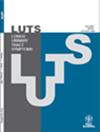The effect of duration between sessions on biofeedback treatment in children with dysfunctional voiding
Abstract
Objective
Biofeedback is an effective treatment in children with standard urotherapy-resistant dysfunctional voiding (DV). However, the duration of the session intervals is not standardized. We aimed to compare the effectiveness of daily and weekly sessions of biofeedback treatments.
Methods
The data of children who received biofeedback due to DV between March 2018 and May 2019 were retrospectively evaluated. The children were divided into two groups, one with daily and the other with weekly sessions. The voiding patterns in uroflowmetry (UF), maximum flow rate (Qmax), electromyography activity, postvoid residual volume (PVR), the ratio of voided volume to expected bladder capacity (EBC) (%), and Dysfunctional Voiding and Incontinence Scoring System (DVISS) were compared between the two groups.
Results
A total of 45 children (39 girls [86.6%] and 6 boys [13.3%]) were included in the study. The daily group consisted of 27 (60%) children and the weekly group of 18 (40%). Qmax, PVR, number of abnormal UF patterns, voiding volume/EBC, and DVISS scores were similar between the two groups before treatment. Voiding parameters improved statistically significantly in both groups following biofeedback, but there was no difference between the two groups. A statistical difference was found between the results of DVISS after treatment (P = .03).
Conclusion
Both types of biofeedback treatment (daily and weekly) are effective methods that improve voiding parameters and DVISS values in children with DV. Therefore, the duration between sessions can be determined according to the suitability of the patient and the biofeedback unit.

 求助内容:
求助内容: 应助结果提醒方式:
应助结果提醒方式:


